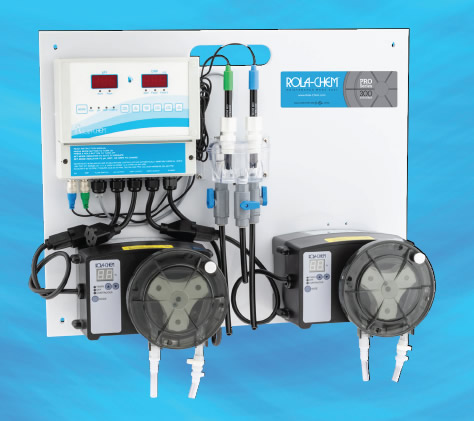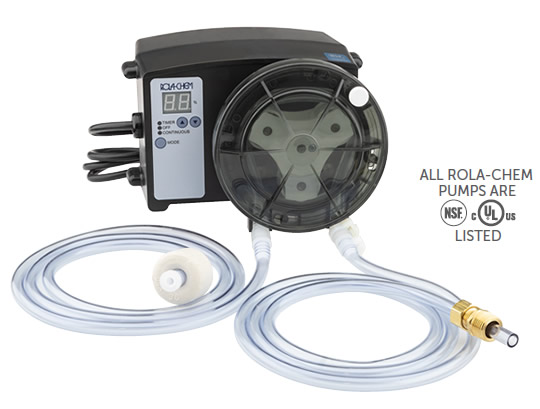Rola- Chem Pro Series Pump PN 5. Sizing chart is based on Rola- Chem or equivalent pumps using 1. All Rola- Chem pumps come with a 1/2. 5- 2 (and RC2. From the Rola- Chem Pro Series Owner's. Manual: Rola- Chem Pro Series Pool Pump. PARTS FOR ROLACHEM RC- 2. CHEMICAL FEEDERS, parts pages for Rola- Chem. Browse All Categories in the Rola-Chem Corp. Catalog including SPA Vac Parts List,M3000 Pool Sentry Parts List.
Rola-Chem Pro Series Pump PN 522105 2013/11/26
Page: 3 of 8
1.15 CAUTION! This pump is for use with permanently installed pools and may also be used with hot tubs
and spas. Do not use with storable pools. A permanently installed pool is constructed in or on the ground or in
a building such that it cannot be readily disassembled for storage. A storage pool is constructed so that it is
capable of being readily disassembled for storage and reassembled to its original integrity.
1.16 CAUTION! --- Service tubing regularly, especially when refilling chemical container. See operation
instruction.
2. SPECIFICATIONS:
Power: 120 volt AC (corded) or 240 volt AC (conduit), 50/60 HZ, 2.5 amp (max.)
Pressure/suction: 30 psi max. dispense line pressure*, 18 foot max. inlet suction lift
Capacity: ESTIMATED MAXIMUM GALLONS PER DAY
SETTING
ON
OFF
RC252
RC25/53
Blue White Industries
RC103
RC503
LO
4 SEC
9 MIN

0.01
0.10
0.34
1.00
2
1.5 MIN
7.5 MIN
0.18
1.20
3.72
8.88
3
3 MIN
6 MIN
0.33
3.60
10.8
24.0
4
4.5 MIN
4.5 MIN
0.50
6.00
19.4
40
5
6 MIN
3 MIN
0.66
8.40
25.2
53
6
7.5 MIN
1.5 MIN
0.78
11.0
33.4
67
HI
9 MIN

4 SEC
0.90
12.0
38
77
Capacity in this table is intended as a guide. Actual output may vary based on actual environment.
3. INSTALLATION:
Tools required – Phillips screwdriver & Adjustable wrench
23/32” drill & ½” pipe tap (NPT) or 7/16” drill & ¼ “ pipe tap(NPT)
1) Install the ROLA-CHEM pump in an area protected from natural elements (sun, rain, freezing, etc.).
Environmental effects may increase required service and maintenance.
The inlet side of the pump must be above the incoming liquid and the chemical container.
Flooded suction is not required or recommended.
Ensure that the tube can be routed without allowing it to kink.
Do not install directly above the chemical container or other equipment that can be damaged by chemicals.
Wall mounting key slots are provided on the rear of the pump enclosure (6.25“ apart for #10 screws).
Comply with local health codes. Cross connections must not allow undesired chemical treatment.
2) The ROLA-CHEM pump is designed to develop a suction lift of 18 feet and to inject into a pressure line of
up to 30 psi*. Do not exceed these limits.
For chlorine pumps, the use of undiluted swimming pool grade, 15% maximum sodium hypochloride is
recommended. For acid pumps, 32% maximum hydrochloric acid feed may be used. See sizing for dilution.
3) Connect the injection fitting into the line to be treated. This should be after heater. Use pipe tape to seal the
pipe threads.
For installation where pressure is greater than 20 psi, use a check valve as the injection fitting or in-line before
injection fitting. One
3
/
8
barbed check valve and one
3
/
8
barbed inlet x ¼ NPT outlet check valve are included
with standard pumps. Use tubing clamp over tube on barbed ends.
*RC503 maximum dispense line pressure is 25psi.
Rola-Chem Pro Series Pump PN 522105 2013/11/26
Page: 2 of 8
Rola Chem Corp
1. Safety: When installing and using this electrical equipment, basic safety precautions
should always be followed, including:
1.1 WARNING !: To reduce the risk of injury, do not permit children to use this product unless they are
closely supervised at all times
Rola Chem Chlorinator
1.2 WARNING !: Risk of electric shock.
Connect only to a grounding type receptacle protected by a ground-fault circuit interrupter (GFCI). Contact
qualified electrician if you can not verify that the receptacle is protected by a GFCI and that your installation
meets local electrical codes, including grounding of water system components.
1.3 WARNING !: Risk of electric shock.
Do not bury or modify the metering pump cord. Locate cord to minimize abuse from lawn mowers, hedge
trimmers, and other equipment
1.4 WARNING !: Risk of electric shock.
On cord and plug connected units, replace a damaged cord immediately.
1.5 WARNING !: Risk of electric shock.
Do not use extension cord to connect unit to electrical supply; provide a properly located outlet
1.6 WARNING !: Risk of electric shock.
Do not install within an outer enclosure or beneath the skirt of a hot tub or sap unless so marked. All
instructions must be in accordance with appropriate electrical codes.
1.7 WARNING !: Risk of electric shock/pinching/chemical exposure.
Remove power sources or lockout circuit prior to performing maintenance on metering pump.
Pumps are usually timer controlled and can start at any time.
1.8 WARNING !: Risk of Chemical Overdose/Exposure.
Removing power from circulating pump must also remove power from the chemical injection pump.
Provide a properly located outlet controlled by the circulating pump circuit.
1.9 WARNING !: Risk of Chemical Overdose/Exposure
Use a devise such as a flow switch to shut-off power from the from the chemical injection pump in the event of
pool pump or circulation failure.
It is not safe to automatically dispensed chemicals into a circulating system that is not running.
1.10 WARNING !: Risk of Chemical Overdose/Exposure
Minimize amount of chemical on site that is available to dispense.
Size the feeder and container to pool/spa capacity.
Dilute chemical for small bodies of water.
1.11 WARNING !: Risk of Chemical Exposure
De-pressurize the system prior to connecting or disconnecting the metering pump.
1.12 CAUTION ! :Wear protective clothing, gloves and safety glasses at all times when working on or near the
metering pump.
1.13 CAUTION !:Install the metering pump and chemical containers in a ventilated secured location. Protect
children, pets, and property from chemical hazards. Containment and/or wash down capability must be in
accordance with local regulations and chemical suppliers’ instructions.
1.14 CAUTION !: Read and follow all instructions supplied with the chemical being fed. User is responsible for
determining the compatibility of the chemical with the metering pump.
Consult supplier of chemical if use and handling instructions are not available.